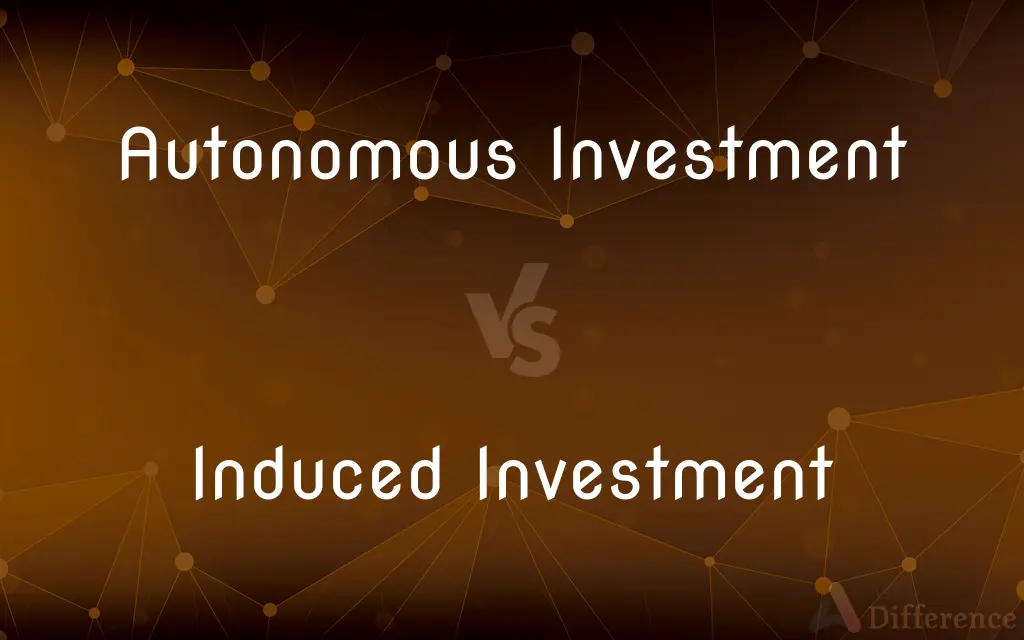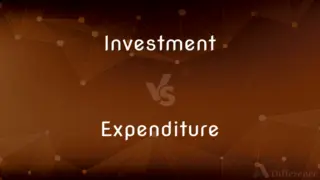Autonomous Investment vs. Induced Investment — What's the Difference?
By Tayyaba Rehman — Published on October 15, 2023
Autonomous Investment vs. Induced Investment: Autonomous Investment is independent of income level, while Induced Investment changes with income.

Difference Between Autonomous Investment and Induced Investment
Table of Contents
ADVERTISEMENT
Key Differences
Autonomous Investment is a type of investment that remains constant regardless of fluctuations in income or economic activity. On the other hand, Induced Investment is influenced by changes in income or economic activity and tends to vary accordingly.
Autonomous Investment can be thought of as the baseline level of investment, dictated by factors like long-term growth expectations or technological advancements. Induced Investment, meanwhile, responds to short-term economic conditions and changes in consumer demand.
When discussing Autonomous Investment, it often represents the essential investments in an economy that will occur irrespective of the current economic situation. In contrast, Induced Investment fluctuates based on the state of the economy and may increase during booms and decrease during recessions.
Factors like government spending on infrastructure or advancements in technology are primary drivers of Autonomous Investment. In comparison, Induced Investment may be spurred by factors like increased consumer spending or a surge in exports.
In economic models, Autonomous Investment helps in establishing a foundation on which to build further analyses. Induced Investment brings in the dynamic aspect, making the models more responsive to real-world situations.
ADVERTISEMENT
Comparison Chart
Dependency on Income
Independent of income level.
Varies with income level.
Nature
Stable and constant.
Fluctuating and responsive.
Driving Factors
Long-term growth, technology advancements.
Economic activity, consumer demand.
Representation in Models
Baseline investment.
Dynamic investment responding to economic conditions.
Economic Phase
Remains constant in booms and recessions.
Increases in booms, decreases in recessions.
Compare with Definitions
Autonomous Investment
Investment driven by factors other than income.
Technological research is typically an Autonomous Investment.
Induced Investment
Dynamic investment in economic models.
Investment in stock markets often represents Induced Investment, changing with economic sentiment.
Autonomous Investment
Investment that doesn't vary with business cycles.
The government's decision to build a new airport is an Autonomous Investment.
Induced Investment
Investment driven by short-term economic conditions.
Businesses increasing inventory due to rising consumer demand showcases Induced Investment.
Autonomous Investment
A constant investment not influenced by economic changes.
Government spending on public roads is an Autonomous Investment.
Induced Investment
Investment that changes with variations in income.
A company expanding its production during economic booms is making an Induced Investment.
Autonomous Investment
Base-level investment in economic models.
The foundational infrastructure projects represent Autonomous Investment in a region.
Induced Investment
Responsive to economic activity.
An increase in the production of luxury goods during prosperous times is an Induced Investment.
Autonomous Investment
An investment that's unaffected by income levels.
Infrastructure development is often an example of Autonomous Investment.
Induced Investment
Varies with consumer demand and economic status.
The opening of new retail stores in response to increased spending is an Induced Investment.
Common Curiosities
What are typical examples of Autonomous Investment?
Government spending on infrastructure or technological research are often examples of Autonomous Investment.
What drives Autonomous Investment?
Factors like long-term growth expectations, technological advancements, or government policies.
In what scenarios would Induced Investment likely increase?
In scenarios of economic growth, increased consumer spending, or a surge in exports.
How is Induced Investment influenced?
Induced Investment is influenced by short-term economic conditions and changes in consumer demand.
Does Autonomous Investment change in recessions?
No, Autonomous Investment remains relatively constant regardless of economic phase.
What is Autonomous Investment?
Autonomous Investment is investment that remains constant, irrespective of fluctuations in income or economic activity.
When might we see a spike in Induced Investment?
During economic booms or periods of high consumer demand.
Can Induced Investment decrease?
Yes, Induced Investment can decrease during economic downturns or recessions.
How does consumer demand impact Induced Investment?
As consumer demand rises, businesses may invest more in production or services, which is Induced Investment.
How does Induced Investment differ from Autonomous Investment?
While Autonomous Investment is independent of income levels, Induced Investment varies with changes in income.
Are all government investments considered Autonomous Investments?
Not necessarily. While many government investments are autonomous, some might respond to economic conditions, making them induced.
How can one distinguish between Autonomous and Induced Investment in a practical scenario?
Look at the driving factors: if it's independent of economic conditions, it's Autonomous; if it varies with conditions, it's Induced.
Why is Autonomous Investment important in economic models?
It establishes a foundational, stable level of investment for further analysis.
Are business cycle fluctuations relevant for Autonomous Investment?
No, Autonomous Investment remains unaffected by business cycle fluctuations.
Can both Autonomous and Induced Investments co-exist in an economy?
Yes, both types of investments co-exist and play distinct roles in an economy's investment landscape.
Share Your Discovery

Previous Comparison
Investment vs. Expenditure
Next Comparison
Encouraging vs. SupportiveAuthor Spotlight
Written by
Tayyaba RehmanTayyaba Rehman is a distinguished writer, currently serving as a primary contributor to askdifference.com. As a researcher in semantics and etymology, Tayyaba's passion for the complexity of languages and their distinctions has found a perfect home on the platform. Tayyaba delves into the intricacies of language, distinguishing between commonly confused words and phrases, thereby providing clarity for readers worldwide.













































